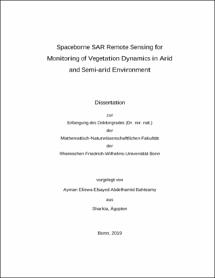Bahteamy, Ayman Eliewa Elsayed Abdelhamid: Spaceborne SAR Remote Sensing for Monitoring of Vegetation Dynamics in Arid and Semi-arid Environment. - Bonn, 2020. - Dissertation, Rheinische Friedrich-Wilhelms-Universität Bonn.
Online-Ausgabe in bonndoc: https://nbn-resolving.org/urn:nbn:de:hbz:5-58361
Online-Ausgabe in bonndoc: https://nbn-resolving.org/urn:nbn:de:hbz:5-58361
@phdthesis{handle:20.500.11811/8311,
urn: https://nbn-resolving.org/urn:nbn:de:hbz:5-58361,
author = {{Ayman Eliewa Elsayed Abdelhamid Bahteamy}},
title = {Spaceborne SAR Remote Sensing for Monitoring of Vegetation Dynamics in Arid and Semi-arid Environment},
school = {Rheinische Friedrich-Wilhelms-Universität Bonn},
year = 2020,
month = apr,
note = {Drylands are under constant threat from multiple stresses and challenges, which occur as a result of a complex interaction of natural processes, and human-induced processes caused by unsustainable land use practices, leading to vegetation degradation and desertification. Understanding the existing distribution of vegetation in the drylands, and changes in vegetation properties in response to climate change and land use change is essential for conservation and sustainable management of vegetation in this environment.
To explore the potential of spaceborne Synthetic Aperture Radar (SAR) data for mapping and monitoring of vegetation, we selected two main case studies in the arid and semi-arid environment in Africa; in the first case study, we integrated SAR data of ALOS/PALSAR with high resolution optical data of RapidEye for mapping of mangroves extents on the Red Sea coastline in Egypt. We applied the object-based image analysis method and evaluated different machine learning algorithms and various input features, such as; spectral properties, texture features, and SAR derived parameters. The object-based analysis allowed clearly discriminating the different land cover classes within mangroves ecosystem, producing accurate maps of mangroves in the study area.
In the second case study, we assessed the impact of drought on grasslands in Eastern Cape Province in South Africa, using multi-temporal analysis of Sentinel-1 SAR backscattering and InSAR coherence and applying linear mixed-effects regression analysis. The study allowed us to detect the impact of drought on communal and commercial grasslands. Results indicated that vegetation dynamics in grasslands ecosystems in the study area are highly responsive to climatic fluctuations. In addition, communal grasslands are more affected by drought impact than commercial grasslands due to the unsustainable use of resources in the communal grasslands, while in commercial grasslands, management activities were able to improve the growing conditions of grasslands.
Results of this research confirmed the feasibility of using Spaceborne SAR data for mapping and monitoring of vegetation state and dynamics in the arid and semi-arid environment in Africa. SAR remote sensing data have shown their potential to derive spatial information from both mangroves ecosystems and grasslands. The elaborated approach can serve as decision‐making support for developing a regional action plan for conservation and management of vegetation in the arid and semi-arid environment, as well as it could be applied for similar applications worldwide.},
url = {https://hdl.handle.net/20.500.11811/8311}
}
urn: https://nbn-resolving.org/urn:nbn:de:hbz:5-58361,
author = {{Ayman Eliewa Elsayed Abdelhamid Bahteamy}},
title = {Spaceborne SAR Remote Sensing for Monitoring of Vegetation Dynamics in Arid and Semi-arid Environment},
school = {Rheinische Friedrich-Wilhelms-Universität Bonn},
year = 2020,
month = apr,
note = {Drylands are under constant threat from multiple stresses and challenges, which occur as a result of a complex interaction of natural processes, and human-induced processes caused by unsustainable land use practices, leading to vegetation degradation and desertification. Understanding the existing distribution of vegetation in the drylands, and changes in vegetation properties in response to climate change and land use change is essential for conservation and sustainable management of vegetation in this environment.
To explore the potential of spaceborne Synthetic Aperture Radar (SAR) data for mapping and monitoring of vegetation, we selected two main case studies in the arid and semi-arid environment in Africa; in the first case study, we integrated SAR data of ALOS/PALSAR with high resolution optical data of RapidEye for mapping of mangroves extents on the Red Sea coastline in Egypt. We applied the object-based image analysis method and evaluated different machine learning algorithms and various input features, such as; spectral properties, texture features, and SAR derived parameters. The object-based analysis allowed clearly discriminating the different land cover classes within mangroves ecosystem, producing accurate maps of mangroves in the study area.
In the second case study, we assessed the impact of drought on grasslands in Eastern Cape Province in South Africa, using multi-temporal analysis of Sentinel-1 SAR backscattering and InSAR coherence and applying linear mixed-effects regression analysis. The study allowed us to detect the impact of drought on communal and commercial grasslands. Results indicated that vegetation dynamics in grasslands ecosystems in the study area are highly responsive to climatic fluctuations. In addition, communal grasslands are more affected by drought impact than commercial grasslands due to the unsustainable use of resources in the communal grasslands, while in commercial grasslands, management activities were able to improve the growing conditions of grasslands.
Results of this research confirmed the feasibility of using Spaceborne SAR data for mapping and monitoring of vegetation state and dynamics in the arid and semi-arid environment in Africa. SAR remote sensing data have shown their potential to derive spatial information from both mangroves ecosystems and grasslands. The elaborated approach can serve as decision‐making support for developing a regional action plan for conservation and management of vegetation in the arid and semi-arid environment, as well as it could be applied for similar applications worldwide.},
url = {https://hdl.handle.net/20.500.11811/8311}
}






